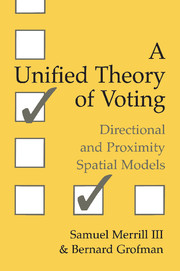Appendices
Published online by Cambridge University Press: 04 December 2009
Summary
Mixed Proximity–RM Models
Following Iversen's (1994) argument that voter utility in a directional model should be idiosyncratically constrained, we have defined the RM model with proximity constraint as a mixed directional and proximity model where β is a mixing parameter. In fact, our formulation, the mixed model of Rabinowitz and Macdonald (1989), and Iversen's (1994) formulation are mathematically equivalent. The formulation we have presented has several advantages over the others. First, the parameter β is easily interpreted as a mixing parameter anchored at 0 and 1 for the pure RM and pure proximity models, respectively. Second, β changes linearly as the indifference plane between the candidates moves from its location for a pure RM model to that for a pure proximity model. Third, the two pure models correspond to straightforward null hypotheses that are convenient to test statistically; namely, β = 0 for the pure RM model and β = 1 for the pure proximity model. By contrast, Rabinowitz and Macdonald's model ratio (equivalent to our 1/β) would have the value of +∞ for a pure RM model, which makes the corresponding null hypothesis awkward to test.
A compromise between Rabinowitz and Macdonald's original idea of an arbitrary circle of acceptability and Iversen's idiosyncratic constraint is the following simpler model, which we call the RM model with centered constraint. It is defined by subtracting from the scalar product utility a multiple of the squared distance from the neutral point to the candidate location.
- Type
- Chapter
- Information
- A Unified Theory of VotingDirectional and Proximity Spatial Models, pp. 170 - 194Publisher: Cambridge University PressPrint publication year: 1999



